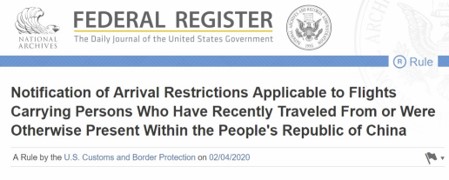Week in Regulation
February 10, 2020
A Net Regulatory Week, Just Barely
The first week of February turned out to be both an active and balanced one in the world of rulemakings. There were 14 actions with some quantified cost or savings estimates. Despite a significant deregulatory measure from the Department of Transportation (DOT), a series of regulatory actions combined to even out the week’s overall ledger. Across all rulemakings, agencies published $16 million in total net costs and added 587,664 hours of annual paperwork.
REGULATORY TOPLINES
- 2020 Proposed Rules: 40
- 2020 Final Rules: 60
- 2020 Total Pages: 7,424
- 2020 Final Rule Costs: $3.4 billion
- 2020 Proposed Rule Costs: $3.6 billion
TRACKING THE REGULATORY BUDGET
The week’s most notable – and most deregulatory – action was an interim final rule from DOT extending the compliance date for a 2016 rule regarding “Minimum Training Requirements for Entry-Level Commercial Motor Vehicle Operators.” The rule pushes back the previously established compliance deadline by two years in order to allow the further development of the Training Provider Registry platform. DOT estimates that, for the purposes of the fiscal year (FY) 2020 regulatory budget, this action will provide $33 million in annualized savings – or $478 million in present value.
The Trump Administration expects to reach $51.6 billion in cumulative net savings in FY 2020. To date in the fiscal year, agencies have finalized 48 deregulatory actions and 15 regulatory actions, totaling $2.4 billion in quantified total net costs.
THIS WEEK’S REGULATORY PICTURE
This week, the Department of Homeland Security (DHS) announces airport restrictions in response to the coronavirus recently identified in China.
Source: https://www.federalregister.gov/documents/2020/02/04/2020-02318/notification-of-arrival-restrictions-applicable-to-flights-carrying-persons-who-have-recently
DHS published a “notification of arrival restrictions” in the February 4 edition of the Federal Register directing all flight operators to “ensure that all flights carrying persons who have recently traveled from, or were otherwise present within, the People’s Republic of China” land at one of seven airports. The seven airports listed were New York (Kennedy), Chicago (O’Hare), San Francisco, Seattle-Tacoma, Honolulu (Inouye), Los Angeles, and Atlanta.
The measure was in response to the recent coronavirus, 2019-nCoV, which was first identified in Wuhan City, China. DHS hopes that limiting access for those who may have been exposed to the coronavirus to these airports where it has “enhanced public health services and protocols” will help prevent its spread in the United States.
The order defines a person subject to the restriction as anyone who “departed from, or was otherwise present within, the People’s Republic of China (excluding the special autonomous regions of Hong Kong and Macau) within 14 days of the date of the person’s entry or attempted entry into the United States.” It excludes crew and flights that only carried cargo.
On February 7, DHS added four more airports to the list: Washington, D.C. (Dulles), Newark, Dallas-Fort Worth, and Detroit. The directive will remain in place until DHS issues a notice rescinding the restrictions.
TOTAL BURDENS
Since January 1, the federal government has published $7 billion in total net costs (with $3.4 billion in finalized costs) and 12.7 million hours of net annual paperwork burden increases (with 537,905 hours due to final rules). Click here for the latest Reg Rodeo findings.












